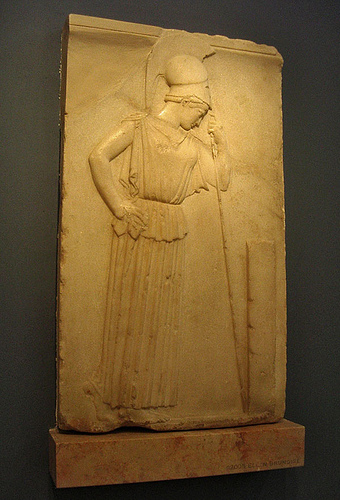If I were to ask you to close your eyes and bring an image to mind of Ancient Greek Art, I am willing to bet it would be statues that cross your vision – crisp representations in white marble of the muscle and sinew of young men; the elegantly draped figures of graceful goddesses; busts of bearded bards and philosophers scowling as if deep in thought. Perhaps an arm is missing here, a hand or foot there, or even a whole head. In the curiosity shop of your memory you are bound to have stored countless images like this even if you haven’t visited Greece. You may have been to the Louvre, the British Museum, the Metropolitan Museum in New York and if not then surely you’ve watched TV, been to the movies and flipped through magazines. The art of Ancient Greece is so entrenched in western civilization that in some shape or form we have all been exposed to it.
Its influence on world art, thought and culture is wide spread and enduring. Greek artists influenced Romans, just as in the early Archaic period, through trade, Egyptians influenced Greece. In this fascinating, eternal ‘game’ of influences, not only have later artists been so obviously inspired by them (Think of Michelangelo or even Rodin), but through their obsession of beauty, Greek sculptors almost dictated what we still see as attractive today. Through time, starting with basic, readily available materials like clay and wood and moving onto limestone, marble and bronze, sculptors discovered anatomy and learned how to portray the human body. Through time Greek Art might look like the art work of a growing child. Yet the art of each period had, in a way, its own sophistication and its own unique beauty. Like all art it reflected the historical, cultural, religious and economic influences of the world it was created in.
Early Archaic figures of young men (Kouroi) and young women (Korai) display mysterious grins and scattered paint remnants. Their shapes vary in size, but always have a monumental feel to them. Other famed statues of the Archaic period are the beautiful Calf Bearer, the Athena’s Cloak of Snakes from the pediment of the Old Temple, the ‘Rampin’ Horseman whose ‘real’ head lives in the Louvre, and the Hunting Dog. Archaic artists were particularly fond of portraying animals, both real and mythical.
The Kritios Boy, is considered quite important because he constitutes a transition from the Archaic (800 – 480 BC) to the Classical periods (500 – 323BC). He is very beautiful, but more importantly, he is the earliest example we have of statues whose weight shifted from being equal on both legs to resting on the back leg. This was a major artistic breakthrough which opened the door for greater possibilities of expression and dynamic. At this time Greek Gods and young athletes exhibited the full beauty of the male form. Yet, at the same time Greek Art moved towards a greater degree of anatomical realism. The statues seem almost alive, but their very beauty makes for a stylization in itself. A gorgeous example of this is Praxiteles’ Hermes in the Museum of Ancient Olympia.
It is only later, in the Hellenistic period (323 – 31BC), that you will see sculpture that is more detailed and realistic. The idea of the portrait is born and humans are depicted not in their ideal, but in their real shape – not that the idea of beauty has been abandoned altogether – only look at the head of a youthful Alexander the Great.
Apart from free standing statues Greeks crafted many pieces of art such as temple pediments, friezes and funeral steles. Exceptional examples are the “Mourning Athena” and the “Niki Adjusting Her Sandal.” The height of artistry over material, however, is found in the Parthenon where Greek sculptor Phidias exhibits such skill that the marble seems to sing and dance.
Related articles

